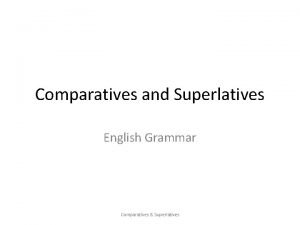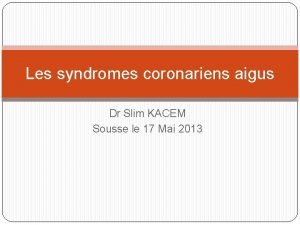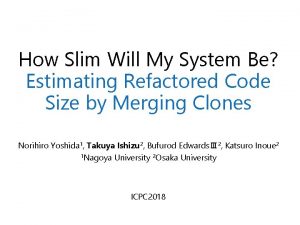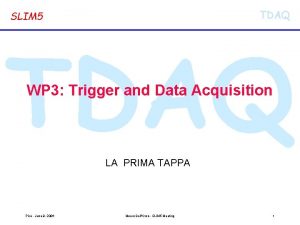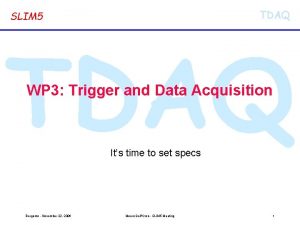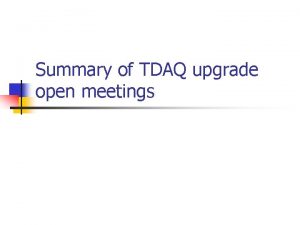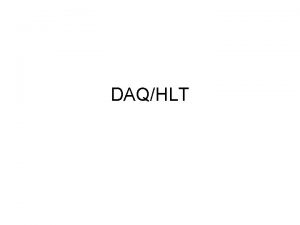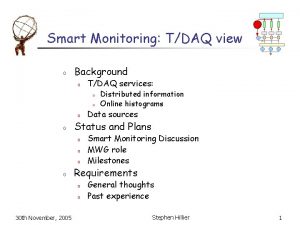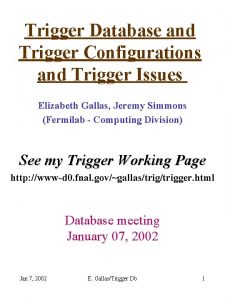TDAQ SLIM TDAQ WP 3 Trigger and Data











- Slides: 11

TDAQ SLIM TDAQ WP 3: Trigger and Data Acquisition Ideas submitted to discussion and cross-examination Contributions from various authors (BO-PI) Pisa - June 24, 2005 Mauro Dell'Orso - SLIM Meeting 1

WP 3: Trigger-DAQ SLIM TDAQ PURPOSE: 1. Record test beam data for offline analysis - Not an hard task 2. Demonstrate Level-1 Trigger Capabilities for experiments at LHC, Super-B, Fixed Target, ILC. . . - Challenging - Partially undefined - Strong interaction with other WP’s Pisa - June 24, 2005 Mauro Dell'Orso - SLIM Meeting 2

Event Pile-up SLIM TDAQ • High luminosity ® Event separation 10 ¸ 100 ns • What readout ? Assume continuous and highly parallel -Clock @ 10 ¸ 100 MHz -Sparsified readout (zero suppression) -Hits of different events mixed on the detector output stream • Possible solution: time stamp on each readout hit -might be not yet available at test beam • Likely use of data buffering waiting for trigger decision • Technical guideline: minimize trigger latency Pisa - June 24, 2005 Mauro Dell'Orso - SLIM Meeting 3

Use of Associative Memory SLIM TDAQ • Managerial guideline: minimize efforts – use existing AM board design, make few changes • Consider time bins identified by stamp ® space-time pixels • Use AM for tracking in space-time ® space-time patterns • Data-driven architecture – Don’t need timing signals to AM • AM’s 18 -bit hit ID gives plenty of address space – 3 ¸ 4 bits for time stamp – 10 bits for 32 x 32 detector pixels Pisa - June 24, 2005 Mauro Dell'Orso - SLIM Meeting 4

AM details SLIM TDAQ • AM needs an end-event word (EE) on each input stream for internal reset and auto-synchronization • With new firmware, AM can accept a specific EE for each time stamp – Send EE to AM at event rate (when no more hits with given time stamp are expected) 2+2 output pipelines per LAMB (both sides) 8 chips each All-parallel input at 40¸ 50 MHz per Si-layer • Reduce AM output pipelines to one stage – Should be adequate for test-beam: 16 chips x 5000 patterns Pisa - June 24, 2005 Mauro Dell'Orso - SLIM Meeting 5

SLIM TDAQ Equivalent event gates Stamped hit sequence: 11112112213112(EE 1)3223(EE 2)3455(EE 3)6445(EE 4) GATE 1 Reset AM subset 2 GATE 2 Reset AM subset 3 GATE 4 GATE 5 Pisa - June 24, 2005 Mauro Dell'Orso - SLIM Meeting 6

Dataflow to acquisition SLIM TDAQ • Pixels: possible use of AM repeaters – AM output consists of matching roads and input coordinates – (Almost) no data buffering necessary • Strips: AM cannot repeat neither pulse heights nor times over threshold – Data buffering before AM for p. h. / t. o. t. recording – Introduce an interface board between strips and AM • Uniformity suggests common AM interface for both Pixels and Strips – Some interface necessary anyhow – This also gives more flexibility – Possible application of CDF Pulsar board Pisa - June 24, 2005 Mauro Dell'Orso - SLIM Meeting 7

AM Interface sketch TDAQ Si-detectors SLIM Timing Pisa - June 24, 2005 Time stamp generation: not takled yet Mauro Dell'Orso - SLIM Meeting 8

SLIM Pisa - June 24, 2005 Cost profile (€) Mauro Dell'Orso - SLIM Meeting TDAQ 9

SLIM MILESTONES • 30 DEC 2006 Trigger-DAQ Architecture • 30 DEC 2007 Most TDAQ boards on production • ? ? xxx 2008 TDAQ system under final test Pisa - June 24, 2005 Mauro Dell'Orso - SLIM Meeting TDAQ 10

SLIM Open questions (subsample) TDAQ • Strip readout (hit cluster finding) • Cables from FE to AM-Interface and their drivers – What’s the border between FE & TDAQ ? – Here we assume it’s on the AM-Interface transition boards • Where are the zeros suppressed? • Start gate from the accelerator? • Fast Super. Pixels to trigger? – Recording high resolution requires data duplication • Time stamp availability – Could be simulated by AM-Interface? • Determination of readout completion for a given time stamp Pisa - June 24, 2005 Mauro Dell'Orso - SLIM Meeting 11
 The boss of mice and men-character personality traits
The boss of mice and men-character personality traits He's medium height
He's medium height Careful comparative and superlative
Careful comparative and superlative George of mice and men-character personality traits
George of mice and men-character personality traits Jack links jerky sasquatch
Jack links jerky sasquatch Sweep line algorithm codeforces
Sweep line algorithm codeforces Stade killip
Stade killip Slim new clone is
Slim new clone is Metabolic slim
Metabolic slim Culebra
Culebra Slim direct characterization quotes
Slim direct characterization quotes Of mice and men whitey
Of mice and men whitey


